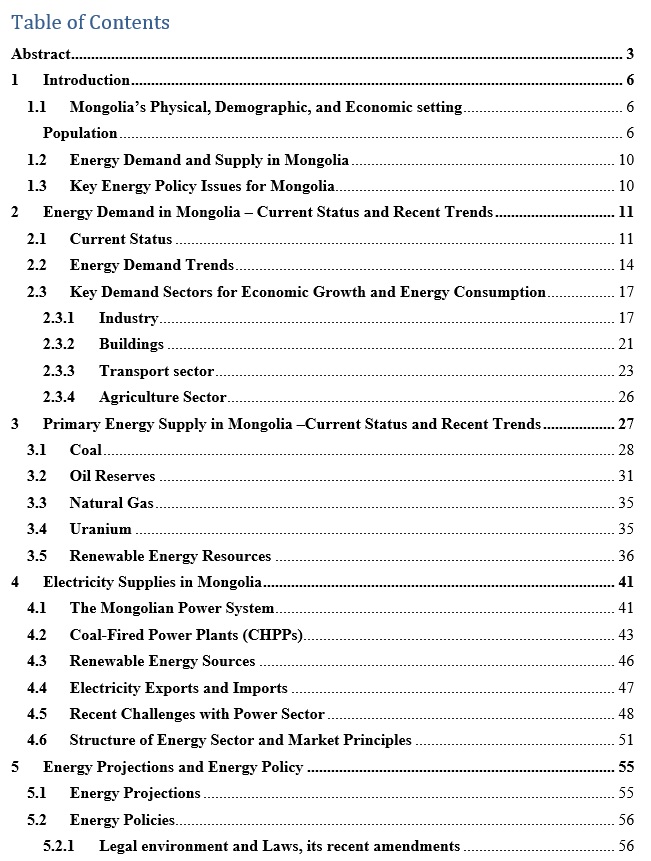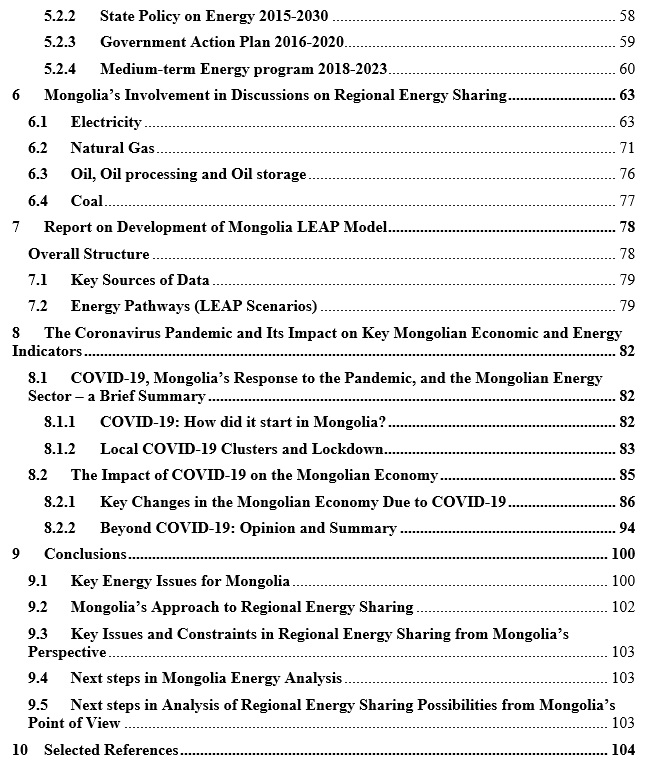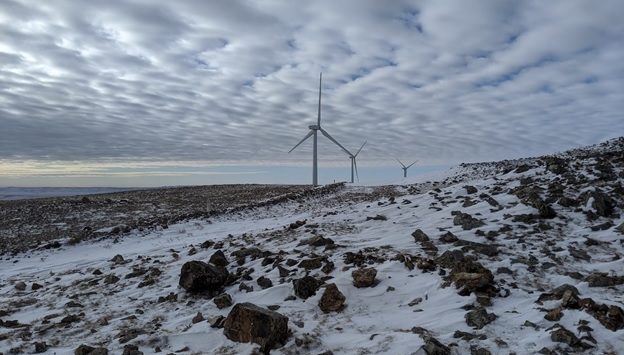OYUNCHIMEG CH, TUYA N, ZORIGT D, SUKHBAATAR TS, BAYARKHUU CH
May 15 2021
I. INTRODUCTION
In this Special Report, Oyunchimeg, Tuya, Zorigt, Sukhbaatar and Bayarkhuu provide an update on the current status and recent trends and challenges in Mongolia’s energy sector, including changes to the Mongolian energy sector and economy as a result of the COVID-19 pandemic. The report provides the results of future energy demand and supply paths for Mongolia prepared by the Working Group. The future paths include “business as usual” projections, and paths in which Mongolia becomes a major electricity exporter. Mongolia’s energy policies and the status of discussions with nations in the region regarding infrastructure for energy sharing are also updated and summarized.
A summary of this report follows. A downloadable PDF file (4.7 MB) of the full report is here
Oyunchimeg Chogdon, is an Independent Energy Analyst; Tuya Nyamosor is a Professor at the School of International Relations, National University of Mongolia; Zorigt Dashdorj, is Executive Director of the Mongolia Development Strategy Institute; Sukhbaatar Tsegmid is Managing Director and CEO of Clean Energy LLC; and Bayarkhuu Chinzorigt is Business Development Manager at Akuo Energy.
The views expressed in this report do not necessarily reflect the official policy or position of the Nautilus Institute. Readers should note that Nautilus seeks a diversity of views and opinions on significant topics in order to identify common ground.
This report is published under a 4.0 International Creative Commons License the terms of which are found here.
Banner image: Salkhit Wind Farm, December 2019. Photo by D. von Hippel.
II. NAPSNET SPECIAL REPORT BY OYUNCHIMEG, TUYA, ZORIGT, SUKHBAATAR AND BAYARKHUU
ENERGY SECTOR CURRENT STATUS, RECENT DEVELOPMENTS AND ENERGY POLICIES IN MONGOLIA
OYUNCHIMEG CH, TUYA N, ZORIGT D, SUKHBAATAR TS, BAYARKHUU CH MAY 15, 2021
Summary
This report is an updated version of the Mongolia Working Group’s Year 1 Regional Energy Security (RES) project report, and as such includes updates of information on the Mongolian energy sector and economy for the years 2018 and 2019. It also provides energy sector and related economic data for January through December 2020 to enable comparisons with previous years and thus to indicate how the COVID 19 pandemic has influenced the economy of Mongolia during 2020. In addition, this update describes amendments approved since 2017 that relate to key Energy and Renewable Energy laws and policies in Mongolia. Additional recent relevant studies and information have been included in the Regional Energy Cooperation section of this report. Information on the recent status of proposed Russian gas transfers though Mongolia, and the construction of the new oil refinery plant in Mongolia have been updated as well, and these updates appear in section 6 of this Report.
In Mongolia, total primary energy supplies continue to be dominated by coal, and electricity generation is largely provided by coal-fired power plants, particularly combined heat and power plants. In 2018, 93% of all electricity was produced by thermal power plants, and 98% of all district heat was provided by coal-fired systems. Mongolia’s renewable energy resources, including wind, solar, geothermal, and hydro, are estimated to be able to provide as much as 2,600 GW of electricity, far exceeding Mongolia’s current generation capacity of about 1 GW. The Gobi Desert in particular has tremendous renewable energy potential and has favorable climatic and weather conditions to allow the effective use of wind and solar resources. Mongolia has modest oil reserves, but exports crude oil and imports oil products, as it lacks refining capacity.
Although Mongolia has abundant resources to produce electricity, it currently lacks sufficient generation capacity to meet its needs, and thus imports power from Russia and China. Power is imported across the northern border to compensate for shortfalls of electricity in the northern central area during winter peak periods. Also, in order to meet the electricity demand of the Oyu Tolgoi copper mine in the south, electricity is imported from China. As a result, Mongolia has been heavily dependent on electricity imports in recent years.
To ensure the reliability and stability of the energy sector, currently operating thermal power plants, district heating plants, and transmission and distribution networks are prioritized for investment, and expansion of capacity, technical and technological rehabilitation and upgrades are ongoing step by step in the energy sector. Also, development of renewable energy sources with limited capacities for domestic use is underway, and the share of renewable generation is increasing slowly from year to year. Local air pollution from power and heating plants located in urban areas, as well as from direct use of heating fuels by households, is a significant concern to be addressed by energy policy.
The government of Mongolia has set targets to increase the share of generation capacity from renewable energy sources to 20% by 2023 and 30% by 2030, and to build export-oriented power plants. The goal of these policies is that Mongolia will become an energy exporting country in the future by utilizing its rich renewable energy resources with efficient and environmentally-friendly technologies while establishing mutually beneficial cooperation with neighboring and regional countries.
9. Conclusions
9.1 Key Energy Issues for Mongolia
The key issues in the energy sector in Mongolia involve economic, social, environmental, financing, governance/regulatory and regional dimensions.[1]
Economic issues
The priority in the energy sector remains expanding the existing electricity generation capacity and building new heat and power generators to meet the growing demand in industry, primarily in the mining subsector, as well as ensuring reliable and cost-effective access to energy in the commercial, residential and transportation sectors, notably in rural areas and urban outskirts.
In the medium-term, the energy sector, along with the transportation sector, should contribute to improved connectivity between different regions of Mongolia. Improving transport and energy services will help to develop the productive sectors of the economy, diversify the sources of economic growth, and build the basis for stronger regional linkages for Mongolia so that the country is able to harness the benefits of broader regional interconnectivity.
Expansion and access efforts in the energy subsectors should include:
- Expanding existing capacity and conducting renovation work at existing power and thermal plants, as well as major coal mines
- Building new power generating plants particularly in Southern Mongolia
- Diversification of energy sources (increasing solar, wind and hydro)
- Using energy-efficient and modern technologies in energy system such as system stabilizers and energy storage
- Expansion and renovation of power sub-stations and overhead transmission lines to increase capacity and reduce transmission losses
- Building an integrated power grid by connecting (and strengthening connections between) the existing regional energy systems
- Oil exploration
- Encouraging energy efficiency and energy conservation, including through regulatory mechanisms
- Building energy and other infrastructure aimed at unlocking the development potential of productive sectors of the economy to diversify away from mining
Social issues
The use of coal-fired cooking and heating stoves in the Ulaanbaatar districts inhabited by low-income migrant dwellers constitutes a major cause of air pollution in the city (and, increasingly, in aimag centers) and thus presents a major health hazard.
In the winter of 2019-2020, air pollution was reduced by 50 percent in Ulaanbaatar, which is considered one of the cities with the most polluted air in the world. The main driver of this reduction was implementation of Resolution No.62 dated February 28, 2018, by which the Government decided to ban raw coal consumption in Ulaanbaatar starting from May 15, 2019, introducing refined coal briquettes as a replacement fuel in order to reduce pollution.
Prior to 2018, 1.2 million tons of raw coal were consumed annually consumed by 220,000 ger district households, causing 80 percent of the air pollution in Ulaanbaatar. With the introduction of refined coal briquettes in the ger district of Ulaanbaatar, the air pollution has been reduced by half, as noted above. Moreover, a second refined coal briquette factory, located in the southern part of Ulaanbaatar, with the capacity to produce 600 000 tonnes of briquettes annually was commissioned and constructed, and an opening ceremony for the new factory was held on 08 December of 2020. The new factory provides the capacity to be able to fully provide the city with refined coal briquettes.
Improving electricity and heat supply to the ger districts and other areas, and ensuring equitable access to energy services, remain important social issue.
Equally, better electricity supply – including off-grid supply – to low-load localities scattered around the country to support the livelihoods of rural residents, reduce rural migration to urban centers, and support regional development and economic diversification, notably through developing local agribusiness and tourism, should help to promote increased economic activity, create jobs, and reduce poverty. Increased use of renewable energy for these purposes should lessen dependence on the external power supplies and thus increase energy security.
Environmental issues
Reducing air pollution and carbon dioxide emissions from fossil fuels combustion and mitigating their impacts remains a major issue to be addressed in Mongolia. Currently, coal accounts for almost 70% of the greenhouse gas emissions in Mongolia. Achieving the government target of increasing the share of renewables in the energy mix to 30 per cent by 2030 should help to alleviate this problem.
In the future, if a natural gas pipeline route passes though Mongolia, a fuel shift from coal-to-gas could be a positive influence for reduction of air pollution, as well as helping to address climate change and other environmental issues.
Financing
More private sector investment and public-private partnership financing schemes in the energy sector should be encouraged, especially in the electricity transmission and distribution sectors and in renewable electricity generation. Private business is likely to be more effective in providing better technology and efficiency in the provision of services than the public sector.
The international financial institutions will remain important sources of both resources and expertise for Mongolia in the face of the scarcity of public funds and the need for capacity development.
The government may also have to consider the further sustainability of continued subsidizing of residential electricity and heat consumers via higher tariffs applied to industrial and commercial consumers.
Additional tariff reform and other measures to ensure the financial sustainability of businesses in the energy sector will be required in the future.
As the energy sector of Mongolia will require considerable investment in the coming decades, there is a continuing urgent need to establish tariffs that support full cost recovery in order to promote increasing private sector participation in energy markets. Tariffs must allow energy sector companies to recoup their investment in infrastructure and operations, and to earn reasonable profits. As such, some recent tariff rates that have been set low enough that subsidies have been needed to compensate for losses by energy sector companies need to be adjusted based on the real cost situations in order to attract investors and private sector companies.)
Policy/Regulatory/Governance
The discussions initiated by the Ministry of Energy on developing an Energy Sector Master Plan for Mongolia should help identify the gaps in the energy sector infrastructure and in human capital that constrain the achievement of the country’s sustainable development goals, identifying and prioritizing key technical, technological and investment needs, assessing the benefits and risks of specific projects, and developing frameworks for risk reduction and practical implementation should be included in the master planning process. World Bank representatives attended the first seminar on the proposed Plan held in November 2018.
Regional Cooperation
In the years ahead, maximizing Mongolia’s renewable energy potential to make it a provider of electricity for a potential cross-border energy grid linking Northeast Asian countries (sometimes referred to as the Asian Super Grid), and using the country’s location between Russia and China to potentially serve as a transit route for power transmission lines and gas pipelines connecting these two countries are seen as important goals to pursue.
These are seen not only as economically attractive projects with spin-off effects on the local economy but also as demonstrations of Mongolia’s willingness to contribute in complementary way to, and participate in, regional economic integration.
9.2 Mongolia’s Approach to Regional Energy Sharing
In the discussion of prospective regional energy sharing arrangements, Mongolia sees itself primarily as an exporter of electricity generated using the solar and wind resources of the Gobi Desert and as the shortest transit route of gas pipelines and electricity transmission lines from Russia to China and onwards.
9.3 Key Issues and Constraints in Regional Energy Sharing from Mongolia’s Perspective
There are at least three key constraints that make regional energy cooperation a challenging endeavor: the amount of the investment needed/the costs associated with implementing ambitious cross-country projects, the security situation in Northeast Asia, where nuclear issues and great power rivalry (including in the area of energy supply) darken the horizons, and the need to harmonize complex non-physical aspects of cooperation such as national rules and regulations in tariffs, prices, transit rules, border procedures etc.
Although said to be technically feasible, the concept of the Asian Super Grid remains a politically challenging project since the level of trust among its potential participants is such that few governments could be expected to fully commit to its implementation and to thus depend on neighbors for the crucial issue of provision of power.
The outstanding issue of addressing the nuclear weapons issue on the Korean peninsula, and the growing major power rivalry in the region, including competition for markets for energy exports, make energy-sharing a more difficult possibility. This should not, however, prevent the region’s expert and professional community from continuing to explore and propose possible options and viable frameworks for regional energy cooperation, and working to shape the debate on the best ways to proceed.
9.4 Next steps in Mongolia Energy Analysis
The Mongolia LEAP model used to prepare the results above considered current Government plans for the energy sector, consistent with the Long-term plan Vision 2050 of Mongolia. The next steps in Mongolia Energy Analysis using LEAP will include further improvements in data collection in some sections, and more detailed quantitative development of a future BAU pathway, followed by more detailed quantitative development and analysis (of physical outputs, costs, environmental emissions, and other energy security considerations) of other future pathways focused on Mongolia (such as more work on coal-based exports, or on conversion from coal-fired heating of buildings to electric heating based on renewables and storage), and of future pathways based on energy cooperation, including large-scale exports of power from renewable energy sources.
9.5 Next steps in Analysis of Regional Energy Sharing Possibilities from Mongolia’s Point of View
In accordance with the “Midterm Action Program Implementing State Policy on Energy” approved by the Government of Mongolia on the 24th of October 2018, the following main measures were planned to expand energy cooperation with neighboring and regional countries:
- Establish long-term agreements on energy trade with neighboring countries
- Cooperate with neighbors to develop energy transit infrastructure within initiatives to create an economic corridor between Russia and China through Mongolia
- Support the Asian Super Grid international initiative and export-oriented energy projects
In addition, the Midterm Action Program includes the following next steps to be considered from the Mongolian side with regard to Regional Energy Sharing.
- To coordinate with other country working groups for the sharing of information and knowledge regarding all relevant initiatives for power interconnection in North-East Asia;
- To carry out joint scientific, research and planning work;
- To enhance the legal environment for investors, and keep the enhanced environment sustainable, for example, through changes in government;
- To have a clear policy governmentally and politically for foreign investments, so as to make rules clear for foreign investors;
- To develop infrastructure in border areas—including railways, roads, and the capacity of customs checkpoints; and
- To strengthen cooperation mechanisms for power interconnection in North-East Asia.


III. NAUTILUS INVITES YOUR RESPONSE
The Nautilus Asia Peace and Security Network invites your responses to this report. Please send responses to: nautilus@nautilus.org. Responses will be considered for redistribution to the network only if they include the author’s name, affiliation, and explicit consent
IV. ENDNOTES
[1] Some of the text presented here is based on concepts in GGGI (2015), Strategies for Development of Green Energy systems in Mongolia (2013-2035), Extended Executive Summary, dated February 2015, and available as http://gggi.org/site/assets/uploads/2017/11/2015-02-Strategies-for-Development-of-Green-Energy-Systems-in-Mongolia-2013-2035.pdf.


